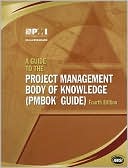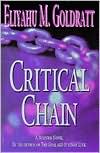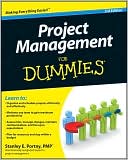Earned Value Management Using Microsoft Office Project: A Guide for Managing Any Size Project Effectively [With CDROM]
This invaluable reference effectively combines earned value management (EVM), the most widely accepted cost management technique, with the most widely used scheduling tool, Microsoft Office Project. It is a practical guide to end-to-end scheduling and cost management and includes a six-month trial version of a unique EVM software tool that will enable you to more effectively manage your projects, track and report the status and progress of projects, and take necessary action before projects...
Search in google:
This invaluable reference effectively combines earned value management (EVM), the most widely accepted cost management technique, with the most widely used scheduling tool, Microsoft Office Project. It is a practical guide to end-to-end scheduling and cost management and includes a six-month trial version of a unique EVM software tool that will enable you to more effectively manage your projects, track and report the status and progress of projects, and take necessary action before projects fail. Supported with practical examples, this guide demonstrates how EVM can be effectively applied to any size project or program with the same rigor as that of a large or critical project or program.
Preface ix Acknowledgments xi About the Author xiii An Introduction to the Chapters xv Web Added Value xix Chapter 1 EVM in Project Management 1 Common Project Management Issues 2 The Solution 2 The EVM Reporting Tool 3 Read Me First Instructions 5 Mock Setup Process 7 Customer Support 8 Chapter 2 Schedule Management 9 Basic Project Management Processes 9 Basic Schedule Elements 10 Work Breakdown Structure 10 Effort Estimates 12 Resources 13 Resource Costs 14 Task Dependencies 16 Chapter 3 What Is EVM? 19 Basic Elements of EVM 19 Planned Value 20 Earned Value 22 Actual Cost 24 Planned Time 26 Elapsed Time 27 Calculation of Earned Value Performance Measures 28 Schedule Variance 29 Schedule Variance Percent 30 Schedule Performance Indicator 32 To-Complete Schedule Performance Indicator 34 Schedule Variance (Time) 36 Schedule Variance Percent (Time) 38 Schedule Performance Indicator (Time) 39 To-Complete Schedule Performance Indicator (Time) 41 Cost/Effort Variance 43 Cost Variance Percent 44 Cost Performance Indicator 46 To-Complete Cost Performance Indicator 48 Budget at Completion 52 Budget at Completion (Time) 52 Estimate to Complete 53 Estimate at Completion 54 Estimate at Completion (Time) 56 Variance at Completion 58 Variance at Completion (Time) 58 Chapter 4 Why EVM? 59 Benefits of EVM Explored 59 Monitors a Project as It Progresses 59 Shows Schedule/Cost Performance at a Glance 61 Uses Numbers Rather than Dates 62 Quantifies and Tracks Delays Caused by External Factors 62 Embraces Change in a Project 63 Makes Project Monitoring Simple 64 Facilitates Having Projects On Time and Under Budget 66 Improves Customer Satisfaction 67 Forecasts Cost/Effort and Time Required 68 ForecastsFuture Efficiency Needed 69 Manages Trends 71 Allows Total Control of a Project 73 Chapter 5 Creating a Schedule 75 Schedule Preparation 75 Setting Up Microsoft Office Project-MPP Options 76 The Schedule Screen 76 The Calendar Options Screen 78 The Project Information Screen 80 The Project Calendar 81 Creating a WBS 83 Assigning Estimates 84 Creating Resources 88 Setting Up the Resource Calendar 89 Assigning Resources 91 Sequencing Lowest-Level Tasks 93 Assigning Priorities to Summary Tasks 96 Creating Recurring Tasks 98 Resource Leveling 101 Baselining the Schedule 106 Chapter 6 Setting Up the EVM Report Template 109 Preparing the Template for a New Project 109 Project Options 109 Configuration Options 111 Populating Reporting Periods 113 Chapter 7 Tracking Progress in the Schedule 117 Tracking Progress in MPP 117 Summary Level Tracking 118 Task Level Day-Wise Tracking 119 Resource Level Day-Wise Tracking 120 Adjusting the Schedule While Tracking 122 Tracking Progress with the EVM Tool 123 Chapter 8 Monitoring the Schedule 129 The Summary Sheet-Checking and Updating 129 The Earned Value Graph 131 The Forecast ($) Graph 132 The Forecast (Time) Graph 133 The Forecast (Index) Graph 134 The Variances ($) Graph 135 The Variances (Time) Graph 136 The Indexes Graph 137 The Other Indexes Graph 138 Chapter 9 Additional Schedule Management Techniques 139 Drilling Down to Check Tasks at Risk 139 Resequencing Tasks in a Schedule 141 Putting a Schedule on Hold 142 An Entire Schedule 142 Selective Resources 142 Updating Resource Leave/Vacation Time 143 Managing Scope Creep 143 When Should a Schedule Be Rebaselined? 144 Rebaselining a Schedule 144 Rebaselining the EVM Report Template 145 Appendix A EVM for Production Support 147 Appendix B Schedule Management - An End-to-End Example 155 Appendix C EVM Template Quick Guide 187 Glossary 193 Index 223




![Microsoft Office Project 2007 Step by Step [With CDROM] Microsoft Office Project 2007 Step by Step [With CDROM]](/application/data/covers/30/57/9780735623057.jpg)



